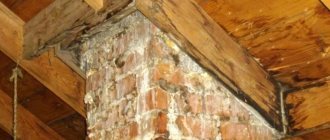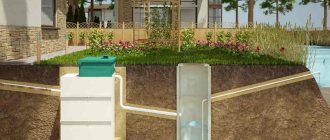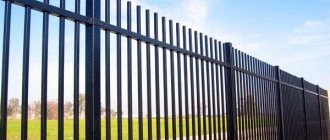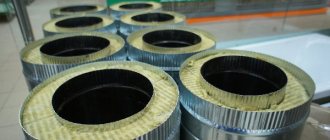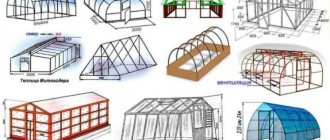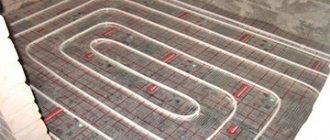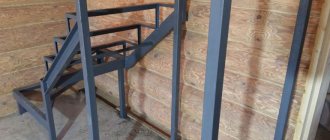Features of HDPE pipes
If you are planning to install a cold water supply system in your local area, I recommend using HDPE pipes. Low-pressure polyethylene pipes have a number of unique properties that are not available to their metal or concrete counterparts.
Advantages and disadvantages
The main quality of HDPE for external systems is ease of installation. Laying and assembling a water pipeline does not require special knowledge. In any hardware store you will find low-density polyethylene pipes of various diameters, sizes and wall thicknesses. In addition, HDPE products have the following features:
- Polyethylene does not react chemically with water transported through the water supply system. That is, the liquid entering the house will not contain impurities.
- HDPE pipes are 7 times lighter than metal products. This makes transportation and installation easier. When laying a water pipeline in a trench, it is not necessary to secure the network with additional supports.
- The smooth inner surface prevents the formation of blockages and growths.
- Products made from HDPE absorb noise; such pipes are convenient for installing sewer systems as risers.
- The cost of the product is lower, installation and transportation are cheaper than metal or concrete pipes.
- HDPE service life is up to 50 years.
Polyethylene pipes can withstand high pressure, temperature changes and are resistant to cracking: if the water in the pipe freezes and increases in volume, this will not affect the integrity of the surface. The disadvantages of HDPE products include low resistance to high ambient temperatures. Therefore, it is advisable to use them for the installation of underground water supply pipelines.
Characteristics
The technical characteristics of the material determine the scope of its application. When making a gas pipeline, you can use different types of plastic pipes. Each of them has its own technical characteristics.
Metal-plastic parameters:
- High chemical resistance.
- The material is not subject to oxidation.
- The maximum coolant temperature is up to 95 degrees.
- The maximum permissible pressure is up to 25 bar. If the temperature is high, the permissible pressure is reduced to 10 bar.
- The thickness of the metal layer between the plastic is up to 0.3 mm.
Characteristics of polyethylene:
- outer diameter of tubes - 10–110 mm;
- maximum coolant temperature - up to 95 degrees;
- at high temperatures the maximum pressure is up to 10 bar.
Polypropylene parameters:
- maximum coolant temperature - 90 degrees;
- permissible pressure at maximum temperature - up to 10 bar.
Polypropylene pipes can withstand short-term overheating up to 110 degrees.
Diameter of plastic pipes
Rules for installation work
Before starting the installation of a pressure water pipeline made of polyethylene pipes, a project for laying the future network is prepared and calculations are carried out. These actions cannot be neglected, otherwise there is a high risk that the water supply system will have to be redone. To prevent this from happening, follow these rules:
- The depth of the trench depends on the freezing of the soil. It is calculated using the formula from the normative collection SNiP 2.02.01-82. A hole is dug in the ground 0.5 m below the freezing depth.
- The water supply network is assembled on the surface of the earth, filled with water under pressure, that is, pressure testing is done to prevent leakage at the joints.
A reliable design is considered to be a water supply system with fewer connections. But it is not always possible to lay HDPE pipes from the well directly to the house. The trench is dug at right angles at turning points.
Tools for installing water pipes
In order to carry out high-quality installation work on laying water pipes in the ground, it is not always necessary to resort to the help of special equipment. Many of the installation devices are available in most homes. You will need the following set of tools:
- pipe cutter, sharp scissors for cutting pipes, knife or hacksaw;
- drill or hammer drill;
- sandpaper;
- construction pencil;
- roulette;
- a set of gas wrenches and wrenches (for tightening fittings tightly);
- soldering iron (if installation will be carried out using hot welding);
- tools for excavation work: shovel, compact crowbar.
To cut pipes evenly and accurately, you need to use special scissors.
Methods for connecting HDPE pipes
The finished project presents a plan for the backbone network: length, turns, connections. At the design stage, even before purchasing materials, they determine the method of fastening the sections together and form a final list of equipment and materials, and calculate the estimated cost of laying.
Butt welding
For a strong, reliable connection of HDPE, butt welding is used. The method is convenient and inexpensive, except for the cost of the welding machine. On average, the price of such equipment is from 180 thousand to 2 million rubles. If you do not have a goal to purchase a machine for welding HDPE pipes, it is better to entrust the joining of sections to a specialized team.
If you are planning to lay the water supply yourself, I will tell you how to do it. The welding machine consists of the following elements:
- centralizer;
- hydraulic unit;
- welding mirror;
- trimmer
Assembly consists of the following steps:
- Secure HDPE pipes in the centralizer on both sides with fastening nuts.
- A manual with a formula is supplied with the welding machine, through which the pressure is calculated for a specific pipe diameter. Having found out the necessary parameters, install them in the hydraulic unit.
- Degrease the edges of the HDPE pipe with alcohol wipes.
- Using a trimmer, smooth out the joints so that there are no burrs.
- After heating the welding mirror, install it between the pipes. Apply pressure to the centralizer until the ends melt 1 centimeter. Reduce the pressure to zero and wait the time specified in the instructions.
- Remove the heating element and connect the pipes.
Within 7–10 minutes the joint hardens, forming a strong connection.
Electrofusion
The electrofusion connection method is suitable for repairing an existing HDPE water supply system. But it can also be used to weld a new system in hard-to-reach places. You will need a welding machine for electrofusion welding and couplings. The cost of couplings depends on the diameter, starting from 200 rubles.
Before starting work, try the coupling on the pipe sections and make marks with a white marker. From the point of cut to the notch, the pipe is cleaned with a scraper to remove the protective oxidative coating and degreased.
An electric coupling is a sleeve with grooves for the contacts of a welding machine. A barcode is pasted on the coupling body, which can be read with a laser pointer included with the device. If for some reason the reading did not occur, then the data can be taken from the coupling passport. The barcode is needed for the machine to automatically select the welding mode.
Having connected the pipes in the coupling, connect the contacts. The device is given the “start” command. The current is supplied to the electrical network located on the inside of the coupling. The pipe begins to melt. The process is considered complete when beacons appear on the surface of the sleeve and the device gives a signal.
Connection with compression fittings
Less reliable methods include connecting with fittings. Leaks may form at the joints, so it is better to use this method for external water supply systems of small diameters.
A fitting is a fastening element. Its components:
- blue clamp cap;
- rubber seal;
- white ferrule;
- sleeve.
To connect a water supply system from HDPE pipes with compression fittings, no additional equipment is required. By welding and electrofusion it is allowed to connect only HDPE pipes of the same diameter, grade and wall thickness, and the variety in fitting models allows you to assemble elements of different sections.
Unscrew the blue clamping nut from the fitting and put it on the pipe. A white ring is attached next. The cleaned and degreased pipe is inserted into the fitting, the ring and nut are tightened, and tightened tightly.
Socket connection
Before couplings and fittings became available in the construction markets, the socket connection method was widely used in pipeline laying. The technology consists of assembling pipes of different diameters: one pipe is inserted into another and the joint is sealed. For sealing, a rubberized coupling is used, previously placed on a wide section of the pipe.
Which way is better
For underground water supply it is better to use the butt welding method. This connection guarantees long-term operation of the system without leaks. The pipe welding process is quick and one person can handle the job.
What does depth depend on?
SNiP lists some factors that influence the determination of depth, which must be taken into account when immersing a water line in the ground, these include:
- The depth of the caisson well above the source of water intake. This factor influences the location of the point of entry of the pipeline into the ground through the walls of the caisson; usually the pressure pipe is mounted as close as possible to the bottom surface.
- The degree of ring rigidity of the pipeline material affects its resistance to soil pressure on the walls, which can lead to damage to the pipeline. The factor must be taken into account when laying plastic water pipelines of large diameters, the maximum depth of which does not exceed 8 meters.
- Soil characteristics (loose, clayey, rocky), presence of vegetation, presence and level of groundwater.
- Installing thermal insulators or electric cables for heating water inside pipes or outside a water supply system can significantly reduce the depth; in this case, complex calculations are required to accurately determine it.
- The location of the point of entry of the external main into the house through its foundation - the lower it is, the greater the depth of the water supply.
- Water temperature at the water intake source.
- The climatic conditions of the region are the lower temperature limit in winter and the highest temperature in summer, the amount of precipitation.
Rice. 3 Map of soil freezing in Russia
Possible difficulties and problems during installation
Before digging a trench, find the underlying communication networks on the technical documentation drawings of the land plot: gas pipeline, telephone, heating, electrical cables. If there is no such documentation, please contact the administration. They have equipment at their disposal that can find an existing utility network at any depth. This will allow you to avoid damaging another network during the process of digging a trench for the water supply.
If the water supply is from a well on the site, no permitting documents are required. But if you are connecting to an existing network or laying a pipe through a neighbor's property, you will need official permission from the local authorities in writing. Otherwise, you may create an emergency situation, which could lead to legal action. It is necessary to agree with neighbors in advance and obtain approval for excavation work.
The problem may be the soil: hard, soft, waterlogged, rocky or unstable. Laying a water pipeline in such conditions will be more expensive, since additional protection and fastening of the entire system will be required.
Manual for SNiP 2.04.02-84
The main problem of subsiding, saline and swelling soils is their low bearing capacity when waterlogged. It can lead to subsidence of the water supply and its damage.
Operational reliability is ensured by:
- The ability of the pipeline to deform without compromising its tightness;
Polyethylene pipes fully possess this property.
- Controlling water leaks;
- Drainage of water in case of leaks into the storm network or into folds of the relief;
- High speed of leak elimination.
When designing a water network on problematic soils, priority is given to above-ground installation. In buildings, water supply is laid above floor level or in a waterproof underground with water drainage in case of leaks.
Problematic soil forced the installation of a main water supply system on supports
Water supply pipelines and storage tanks should be located in areas with a minimum soil thickness and low bearing capacity, with mandatory drainage arrangements.
Water storage tank
In areas with a probability of soil subsidence of 20 cm or more, only pipes with welded joints (both steel and polymer) should be used for water supply systems of supply availability categories 1 and 2. For water supply systems of the 3rd category, it is permissible to use pipes with socket connections, provided they are sealed with elastic rings and cuffs.
Welding a connection for a polyethylene water main
However: if the water pressure is more than 6 kgf/cm2, only a steel pipe can be used on subsidence soils.
When laying steel underground pipelines on saline soils, special attention should be paid to protecting them from corrosion.
One of the protection methods: a steel pipe is placed in a polyethylene sheath with thermal insulation and a heating cable
Step-by-step instructions for doing the installation yourself
When the plan and estimate are ready, the material has been purchased and the connection method has been selected, you can begin laying HDPE in the ground.
Step 1
At the first stage, they dig a trench according to a previously developed scheme. The shape of the excavation depends on the type of soil and the depth of groundwater. Simple and less labor-intensive - rectangular shape. This option should be chosen when the trench depth is no more than 1.5 meters, since this method does not provide for strengthening the walls.
A popular shape is trapezoidal. It is allowed for laying water pipes from HDPE to a depth of 1.5 meters and below, which is relevant for most of Russia. In this case, there is no need to additionally strengthen the walls.
In places where groundwater lies close, it is recommended to choose a mixed form with reinforcement. The width is determined based on the data of the SNiP 2.04.02-84 collection. On average, it varies from 0.5 to 0.8 meters.
If the water supply route is located in a place that is difficult for equipment to reach or the length is short - 5–10 meters, you can dig a trench manually. In other cases, it is better to contact an excavator, especially if the water source is located outside the site and runs into an existing water supply.
Along the route, pegs are driven in on both sides of the future trench, and a rope is pulled. In the future, this will become a guideline for excavation. The land is dumped.
Step 2
The next step is to assemble the HDPE pipes into a complete water supply system. Water is supplied under pressure to check the seal. If the water supply is long and it is inconvenient to install it on the surface, sections of pipes are laid directly in the trench. In this case, it is better to weld using the coupling method. Next, you need to insulate the pipeline along its entire length.
Before laying, the bottom of the trench is covered with a 15 centimeter layer of sand. You should also fill the laid HDPE pipe with sand, this will facilitate access to the system in case of an emergency.
Step 3
The last step is cutting into the house, installing shut-off valves. The soil from the dump is poured back into the trench and leveled.
Regulatory documents conditions and requirements for pipeline construction
The standards determine the laying of any pipeline, regardless of what material it is made of. Many technical issues are regulated in the so-called SNiPs.
Watch the video
They ensure safety and allow any work to be carried out efficiently. Here are a number of requirements that must be met for installation in the ground.
- Accounting is required for the point at which the soil freezes. Its level is often 1.4 meters. In winter, the water inside the water supply will simply freeze if it is located lower. The operation of the water supply will become impossible.
- The laying and its method may vary depending on what structures and structures are already present on the territory. And from the presence of highways, communication networks, highways. It is better to contact specialized companies if you are not completely sure about where to carry out the installation.
- The characteristics of the soil and topography are important for those who lay underground water pipes.



